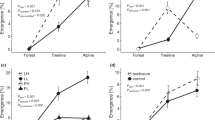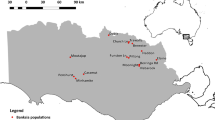Abstract
Seedling survival plays a critical role in maintaining a supply of potential recruits. We examined seedling recruitment, survival and growth in Wollemia nobilis, a rare, long-lived Australian conifer. Wollemia nobilis seedlings and juveniles were monitored for 16 years (1996–2011). While W. nobilis can recruit from seed and, unlike most conifers, persist through resprouting, seed-based recruitment was the primary focus of this study. Sixty-five per cent of new seedlings died within their first year and only 7 % persisted for the 16-year monitoring period. However, 44 % of established juvenile plants (of unknown age at the beginning of the study) persisted throughout the 16-year monitoring period. Growth of seedlings and juveniles was very slow; growth estimates for most individuals had 95 % confidence intervals that included zero. The recruitment strategy of W. nobilis may be to maintain a slow-growing juvenile bank—a strategy typical of other shade-tolerant rainforest trees, including other Araucariaceae. Seedling recruitment in W. nobilis may act together with resprouting to maintain the population.



Similar content being viewed by others
References
Alvarez-Buylla ER, Garcia-Barrios R, Lara-Moreno C, Martínez-Ramos M (1996) Demographic and genetic models in conservation biology: applications and perspectives for tropical rain forest tree species. Annu Rev Ecol Syst 27:387–421
Banks J (2002) Wollemi pine: tree find of the 20th century. In: Dargavel J, Gaughwin D, Libbis B (eds) Austalia’s ever-changing forests V. Proceedings of the fifth national conference on Australian forest history, pp 85–89
Bates D, Maechler M, Bolker B (2012) Package ‘lme 4’. http://cran.r-project.org/web/packages/lme4/lme4.pdf
Bellingham PJ, Sparrow AD (2000) Resprouting as a life history strategy in woody plant communities. Oikos 89:409–416
Benson J, Allen C (2007) Vegetation associated with Wollemia nobilis (Araucariaceae). Cunninghamia 10:255–262
Benson D, McDougall L (1995) Ecology of Sydney plant species: part 3: dicotyledon families Cabombaceae to Eupomatiaceae. Cunninghamia 4:217–431
Benson D, McDougall L (1997) Ecology of Sydney plant species: part 5 dicotyledon families Flacourtiaceae to Myrsinaceae. Cunninghamia 5:330–544
Benson D, McDougall L (1998) Ecology of Sydney plant species: part 6 dicotyledon family Myrtaceae. Cunninghamia 5:808–987
Bond W (1989) The tortoise and the hare: ecology of angiosperm dominance and gymnosperm persistence. Biol J Linn Soc 36:227–249
Bond WJ, Midgley JJ (2003) The evolutionary ecology of sprouting in woody plants. Int J Plant Sci 164:S103–S114
Bond WJ, Scott AC (2010) Fire and the spread of flowering plants in the Cretaceous. N Phytol 188:1137–1150
Boyce MS (1992) Population viability analysis. Annu Rev Ecol Syst 23:481–506
Brokaw NVL (1985) Gap-phase regeneration in a tropical forest. Ecology 66:682–687
Bureau of Meteorology (2013) Weather station data. http://www.bom.gov.au/climate/data/stations. Accessed Oct 2013
Burrows GE, Bullock S (1999) Leaf anatomy of Wollemi pine (Wollemia nobilis, Araucariaceae). Aust J Bot 47:795–806
Burrows GE, Offord CA, Meagher PF, Ashton K (2003) Axillary meristems and the development of epicormic buds in Wollemi pine (Wollemia nobilis). Ann Bot 92:835–844
Caughley G (1994) Directions in conservation biology. J Anim Ecol 63:215–244
Connell JH, Green PT (2000) Seedling dynamics over thirty-two years in a tropical rain forest tree. Ecology 81:568–584
De Steven D (1994) Tropical tree seedling dynamics: recruitment patterns and their population consequences for three canopy species in Panama. J Trop Ecol 10:369–383
Del Tredici P (2001) Sprouting in temperate trees: a morphological and ecological review. Bot Rev 67:121–140
Delcamp M, Gourlet-Fleury S, Flores O, Gamier E (2009) Can functional classification of tropical trees predict population dynamics after disturbance? J Veg Sci 19:209–220
Delissio LJ, Primack RB, Hall P, Lee HS (2002) A decade of canopy-tree seedling survival and growth in two Bornean rain forests: persistence and recovery from suppression. J Trop Ecol 18:645–658
Dietze MC, Clark JS (2008) Changing the gap dynamics paradigm: vegetative regeneration control on forest response to disturbance. Ecol Monogr 78:331–347
Eckert CG (2002) The loss of sex in clonal plants. Evol Ecol 15:501–520
Enright NJ, Hill RS (1995) Ecology of the southern conifers. Smithsonian Institution Press, Washington, DC
Enright NJ, Ogden J, Rigg LS (1999) Dynamics of forests with Araucariaceae in the western Pacific. J Veg Sci 10:793–804
Enright NJ, Miller BP, Perry GLW (2003) Demography of the long-lived conifer Agathis ovata in maquis and rainforest, New Caledonia. J Veg Sci 14:625–636
Fox GA (2001) Failure time analysis. Studying times to events and rates at which events occur. In: Scheiner S, Gurevitch J (eds) Design and analysis of ecological experiments. Oxford University Press, New York, pp 235–266
Gill AM, Ashton DH (1968) Role of bark type in relative tolerance to fire of three central Victorian eucalypts. Aust J Bot 16:491–498
Harper JL (1977) Population biology of plants. Academic Press, London
Hill R, Brodribb T (1999) Turner review no. 2. Southern conifers in time and space. Aust J Bot 47:639–696
Itoh A, Yamakura T, Ogino K, Seng Lee H, Ashton PS (1997) Spatial distribution patterns of two predominant emergent trees in a tropical rainforest in Sarawak, Malaysia. Plant Ecol 132:121–136
IUCN (International Union for the Conservation of Nature) (2001) IUCN Red List categories and criteria: version 3.1, 2nd edn. IUCN, Gland
IUCN (International Union for the Conservation of Nature) (2011) The IUCN Red List of threatened species: Wollemia nobilis. http://www.iucnredlist.org/details/34926/0. Accessed 1 July 2013
Johnston R, Lacey C (1983) Multi-stemmed trees in rainforest. Aust J Bot 3:189–195
Jones W, Hill K, Allen J (1995) Wollemia nobilis, a new living Australian genus and species in the Araucariaceae. Telopea 6:173–176
Kelly D, Sork VL (2002) Mast seeding in perennial plants: why, how, where? Annu Rev Ecol Syst 33:427–447
Kershaw P, Wagstaff B (2001) The southern conifer family Araucariaceae: history, status, and value for paleoenvironmental reconstruction. Annu Rev Ecol Syst 32:397–414
Kershaw P, Clark JS, Gill AM, D’Costa DM (2002) A history of fire in Australia. In: Bradstock RA, Williams J, Gill AM (eds) Flammable Australia: the fire regimes and biodiversity of a continent. Cambridge University Press, Cambridge, pp 3–25
Lawes MJ, Richards A, Dathe J, Midgley JJ (2011) Bark thickness determines fire resistance of selected tree species from fire-prone tropical savanna in north Australia. Plant Ecol 212:2057–2069
Macphail M, Hill K, Partridge A, Truswell E, Foster C (1995) Wollemi Pine—old pollen records for a newly discovered genus of gymnosperm. Geol Today 11:48–49
McDowell N, Pockman WT, Allen CD, Breshears DD, Cobb N, Kolb T, Plaut J, Sperry J, West A, Williams DG, Yepez EA (2008) Mechanisms of plant survival and mortality during drought: why do some plants survive while others succumb to drought? N Phytol 178:719–739
McLoughlin S, Vajda V (2005) Ancient Wollemi pines resurgent. Am Sci 93:540–547
Montgomery R, Chazdon R (2002) Light gradient partitioning by tropical tree seedlings in the absence of canopy gaps. Oecologia 131:165–174
Nagalingum NS, Drinnan AN, Lupia R, McLoughlin S (2002) Fern spore diversity and abundance in Australia during the Cretaceous. Rev Palaeobot Palynol 119:69–92
New South Wales Department of Conservation (2006) Wollemi pine recovery plan. NSW DEC, NSW, pp 1–47
New South Wales Parks and Wildlife Service (2001) Wollemi national park plan of management. NPWS, NSW, pp 1–69
Offord C, Porter C, Meagher P, Errington G (1999) Sexual reproduction and early plant growth of the Wollemi pine (Wollemia nobilis), a rare and threatened Australian conifer. Ann Bot 84:1–9
Peakall R, Ebert D, Scott LJ, Meagher PF, Offord CA (2003) Comparative genetic study confirms exceptionally low genetic variation in the ancient and endangered relictual conifer, Wollemia nobilis (Araucariaceae). Mol Ecol 12:2331–2343
Pinard MA, Huffman J (1997) Fire resistance and bark properties of trees in a seasonally dry forest in eastern Bolivia. J Trop Ecol 13:727–740
R Core Team (2013) R: a language and environment for statistical computing. R Foundation for Statistical Computing, Vienna, Austria. http://www.R-project.org/. Accessed 26 April 2013
Rees M, Condit R, Crawley M, Pacala S, Tilman D (2001) Long-term studies of vegetation dynamics. Science 293:650–654
Rigg LS, Enright NJ, Jaffré T, Perry GLW (2010) Contrasting population dynamics of the endemic New Caledonian conifer Araucaria laubenfelsii in maquis and rain forest. Biotropica 42:479–487
Rüger N, Huth A, Hubbell SP, Condit R (2009) Response of recruitment to light availability across a tropical lowland rain forest community. J Ecol 97:1360–1368
Sanguinetti J, Kitzberger T (2008) Patterns and mechanisms of masting in the large-seeded southern hemisphere conifer Araucaria araucana. Aust Ecol 33:78–87
Silvertown J (1987) Introduction to plant population ecology. Longman Group, United Kingdom
Spies AN, Gray TA (1996) Gap size, within-gap position and canopy structure effects on conifer seedling establishment. J Ecol 84:635–645
Steward G, Beveridge A (2010) A review of New Zealand kauri (Agathis australis (D. Don) Lindl.): its ecology, history, growth and potential for management for timber. NZ J For Sci 40:33–59
Therneau T (2013) A package for survival analysis in S. R package version 2.37-4. http://CRAN.R-project.org/package=survival. Accessed 26 April 2013
Tilman D (1994) Competition and biodiversity in spatially structured habitats. Ecology 75:2–16
Turner IM (1990) Tree seedling growth and survival in a Malaysian rain forest. Biotropica 22:146–154
Underwood AJ (1997) Experiments in ecology: their logical design and interpretation using analysis of variance. Cambridge University Press, Cambridge
Whitmore T (1989) Canopy gaps and the two major groups of forest trees. Ecology 70:536–538
Acknowledgments
For data collection we thank W. Jones, J. Allen and C. Pavich. For data collection and field assistance we thank S. Clarke. We thank the anonymous reviewer for their constructive feedback. This work was supported by the Wollemi Pine Recovery Team, Office of Environment and Heritage (NSW), NSW National Parks and Wildlife Service, Royal Botanic Gardens and Domain Trust. H. Z. is supported by an Australian Post-graduate Award and the Sidney Perry Foundation.
Author information
Authors and Affiliations
Corresponding author
Electronic supplementary material
Below is the link to the electronic supplementary material.
Rights and permissions
About this article
Cite this article
Zimmer, H.C., Auld, T.D., Benson, J. et al. Recruitment bottlenecks in the rare Australian conifer Wollemia nobilis . Biodivers Conserv 23, 203–215 (2014). https://doi.org/10.1007/s10531-013-0593-2
Received:
Accepted:
Published:
Issue Date:
DOI: https://doi.org/10.1007/s10531-013-0593-2




